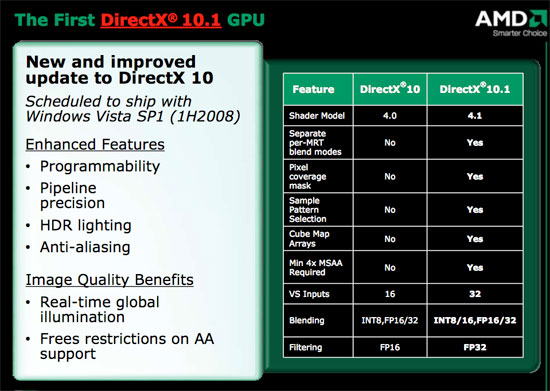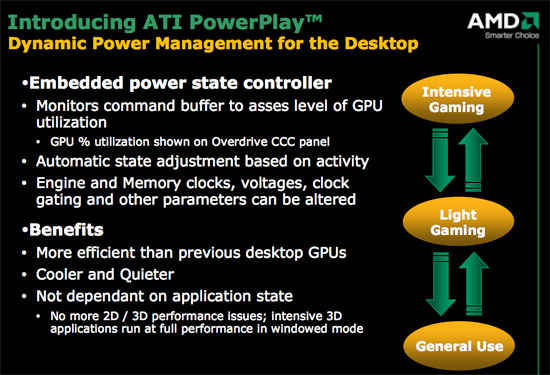ATI Radeon HD 3870 & 3850: A Return to Competition
by Anand Lal Shimpi & Derek Wilson on November 15, 2007 12:00 AM EST- Posted in
- GPUs
New Features you Say? UVD and DirectX 10.1
As we mentioned, new to RV670 are UVD, PowerPlay, and DX10.1 hardware. We've covered UVD quite a bit before now, and we are happy to learn that UVD is now part of AMD's top to bottom product line. To recap, UVD is AMD's video decode engine which supports decode, deinterlacing, and post processing for video playback. The key features of UVD are full decode support for both VC-1 and H.264. MPEG-2 decode is also supported, but the entropy decode step is not performed for MPEG-2 video in hardware. The advantage over NVIDIA hardware is the inclusion of entropy decode support for VC-1 video, but this tends to be overplayed by AMD. VC-1 is lighter weight than H.264, and the entropy decode step for VC-1 doesn't make or break playability even on lower end CPUs.
DirectX 10.1 is basically a release of DirectX that clarifies some functionality and adds a few features. Both AMD and NVIDIA's DX10 hardware support some of the DX10.1 requirements, but since they don't support everything they can't claim DX10.1 as a feature. Because there are no capability bits, game developers can't rely on any of the DX10.1 features to be implemented in DX10 hardware.

It's good to see AMD embracing DX10.1 so quickly, as it will eventually be the way of the world. The new capabilities that DX10.1 enables are enhanced developer control of AA sample patterns and pixel coverage, blend modes can be unique per render target rather, vertex shader inputs are doubled, fp32 filtering is required, and cube map arrays are supported which can help make global illumination algorithms faster. These features might not make it into games very quickly, as we're still waiting for games that really push DX10 as it is now. But AMD is absolutely leading NVIDIA in this area.
Better Power Management
As for PowerPlay, which is usually found in mobile GPUs, AMD has opted to include broader power management support in their desktop GPUs as well. While they aren't to wholly turn off parts of the chip, clock gaiting is used, as well as dynamic adjustment of core and memory clock speed and voltages. The command buffer is monitored to determine when power saving features need to be applied. This means that when applications need the power of the GPU it will run at full speed, but when less is going on (or even when something is CPU limited) we should see power, noise, and heat characteristics improve.

One of the cool side effects of PowerPlay is that clock speeds are no longer determined by application state. On previous hardware, 3d clock speeds were only enabled when a fullscreen 3D application started. This means that GPU computing software (like folding@home) was only run at 2D clock speeds. Since these programs will no doubt fill the command queue, they will get full performance from the GPU now. This also means that games run in a window will perform better which should be good news to MMO players everywhere.
But like we said, dropping 55nm parts less than a year after the first 65nm hardware is a fairly aggressive schedule and one of the major benefits of the 3800 series and an enabler of the kind of performance this hardware is able to deliver. We asked AMD about their experience with the transition from 65nm to 55nm, and their reply was something along the lines of: "we hate to use the word flawless... but we're running on first silicon." Moving this fast even surprised AMD it seems, but it's great when things fall in line. This terrific execution has served to put AMD back on level competition with NVIDIA in terms of release schedule and performance segment. Coming back from the delay in R600 to hit the market in time to compete with 8800 GT is a huge thing and we can't stress it enough. To spoil the surprise a bit, AMD did not outperform 8800 GT, but this schedule puts AMD back in the game. Top performance is secondary at this point to solid execution, great pricing, and high availability. Good price/performance and a higher level of competition with NVIDIA than the R600 delivered will go a long way to reestablish AMD's position in the graphics market.
Keeping in mind that this is an RV GPU, we can expect AMD to have been working on a new R series part in conjunction with this. It remains to be seen what (and if) this part will actually be, but hopefully we can expect something that will put AMD back in the fight for a high end graphics part.
Right now, all that AMD has confirmed is a single slot dual GPU 3800 series part slated for next year, which makes us a little nervous about the prospect of a solid high end single GPU product. But we'll have to wait and see what's in store for us when we get there.










117 Comments
View All Comments
ChronoReverse - Friday, November 16, 2007 - link
I'll third that. The lines are great. Let's me know the resolution scaling quickly too.peldor - Thursday, November 15, 2007 - link
The line graphs are an improvement over the bar graphs. Good use of colors on these charts too.Anand Lal Shimpi - Thursday, November 15, 2007 - link
I think this is honestly one of the best ideas I've ever heard. If I were talented enough to make a good looking hand puppet...Take care,
Anand
xsilver - Thursday, November 15, 2007 - link
pfft. hand puppets,you need 3d virtual godzilla representing nvidia and 3d virtual king kong representing amd. BTW godzilla would win because it can shoot flames out of its mouth. :P
about the article - is it not feasible that when the price of the 8800gt drops to $220 or lower the 3870 just needs to drop to 85% of that mark? With the 3870 being on the smaller die process, they could afford it or at least try to?
Anand Lal Shimpi - Thursday, November 15, 2007 - link
ohhhhhk, I just said that I'm not talented enough to make a couple of hand puppets, you expect me to be able to create 3D models of reptiles and animate them? I picked text as a medium for my artistic expression for a reason - I'm not exactly artistic otherwise ;)The thought of a $220 8800 GT and a $187 3870 (and thus an even cheaper 3850) is just too much for my mind to handle at this point. I think it'll eventually happen, but not in the near term, these things are too new and both companies like making money.
Take care,
Anand
Anonymous Freak - Thursday, November 15, 2007 - link
Will you do a comparison on CrossFire performance, say, comparing two 3870s to two 8800GTs on X48 vs. 680i? Or even two 3870s on X48 vs. even ONE 8800 Ultra? If 3870 can really sell for $219, or 3850 for less than $200, two of them might well blow away an 8800 Ultra in $/fps terms, even worse than 8800 GT SLI does.Anand Lal Shimpi - Thursday, November 15, 2007 - link
Ask and you shall receive, I just added two new pages to the article - the new Page 10 tackles the CrossFire question.Take care,
Anand
wpapolis - Friday, November 16, 2007 - link
First off, great article! I still surf other web sites but when I read articles produced by Anandtech, they are usually more informative and better presented. Anand, you have a great sense of the relevant information to include in your articles and I do appreciate your effort.Just one small thing regarding CrossFire performance. I was a little disappointed when I read your comment ...
"Scaling looks pretty good from the Radeon HD 3850, however it's still not as good as what NVIDIA is able to achieve with the 8800 GT. NVIDIA consistently achieves about 11% better scaling from one to two GPUs than AMD."
You mentioned that scaling of the 3850's isn't as good as a 8800 GT. In this case, did you compared ...
2 x 3850's with 256MB per card
vs. 2 x 8800 GT's with 512MB per card?
If so, I would be interested in how well ...
2 x 3870's with 512MB per card compares.
I suspect that running a Crossfire configuration sucks up more RAM, so using a 256MB cards doesn't scale as well as using 512MB+ cards.
I know, I know, you didn't get 2 x 3870's, but maybe you can get one more now? Maybe one more page to this article?
Thanks again for your tremendous effort!
Bill
chrispyski - Thursday, November 15, 2007 - link
Nice crossfire chart. I know many people will be thinking about CF'ing the 3850's over a single high-end card (although I totally agree, it does not really work out well in the end)chucky2 - Thursday, November 15, 2007 - link
Those that could have waited for the 3850 and instead bought a 8600 or 2400/2600 are probably kicking themselves right now...Chuck